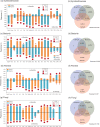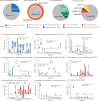The diversity, community dynamics, and interactions of the microbiome in the world's deepest blue hole: insights into extreme environmental response patterns and tolerance of marine microorganisms
- PMID: 37861344
- PMCID: PMC10883803
- DOI: 10.1128/spectrum.00531-23
The diversity, community dynamics, and interactions of the microbiome in the world's deepest blue hole: insights into extreme environmental response patterns and tolerance of marine microorganisms
Abstract
This study comprehensively examined the community dynamics, functional profiles, and interactions of the microbiome in the world's deepest blue hole. The findings revealed a positive correlation between the α-diversities of Symbiodiniaceae and archaea, indicating the potential reliance of Symbiodiniaceae on archaea in an extreme environment resulting from a partial niche overlap. The negative association between the α-diversity and β-diversity of the bacterial community suggested that the change rule of the bacterial community was consistent with the Anna Karenina effects. The core microbiome comprised nine microbial taxa, highlighting their remarkable tolerance and adaptability to sharp environmental gradient variations. Bacteria and archaea played significant roles in carbon, nitrogen, and sulfur cycles, while fungi contributed to carbon metabolism. This study advanced our understanding of the community dynamics, response patterns, and resilience of microorganisms populating the world's deepest blue hole, thereby facilitating further ecological and evolutional exploration of microbiomes in diverse extreme environments.
Keywords: deepest blue hole; extreme environment; microbiome community dynamics; response pattern; tolerance threshold.
Conflict of interest statement
The authors declare no conflict of interest.
Figures








Similar articles
-
Microbial communities related to the sulfur cycle in the Sansha Yongle Blue Hole.Microbiol Spectr. 2023 Aug 25;11(5):e0114923. doi: 10.1128/spectrum.01149-23. Online ahead of print. Microbiol Spectr. 2023. PMID: 37623326 Free PMC article.
-
Microbiome community and complexity indicate environmental gradient acclimatisation and potential microbial interaction of endemic coral holobionts in the South China Sea.Sci Total Environ. 2021 Apr 15;765:142690. doi: 10.1016/j.scitotenv.2020.142690. Epub 2020 Oct 3. Sci Total Environ. 2021. PMID: 33071127
-
Depth shapes microbiome assembly and network stability in the Mariana Trench.Microbiol Spectr. 2024 Jan 11;12(1):e0211023. doi: 10.1128/spectrum.02110-23. Epub 2023 Dec 12. Microbiol Spectr. 2024. PMID: 38084983 Free PMC article.
-
Non-negligible roles of archaea in coastal carbon biogeochemical cycling.Trends Microbiol. 2023 Jun;31(6):586-600. doi: 10.1016/j.tim.2022.11.008. Epub 2022 Dec 23. Trends Microbiol. 2023. PMID: 36567186 Review.
-
Microbial diversity in extreme environments.Nat Rev Microbiol. 2022 Apr;20(4):219-235. doi: 10.1038/s41579-021-00648-y. Epub 2021 Nov 9. Nat Rev Microbiol. 2022. PMID: 34754082 Review.
Cited by
-
DNA metabarcoding reveals ecological patterns and driving mechanisms of archaeal, bacterial, and eukaryotic communities in sediments of the Sansha Yongle Blue Hole.Sci Rep. 2024 Mar 21;14(1):6745. doi: 10.1038/s41598-024-57214-8. Sci Rep. 2024. PMID: 38509179 Free PMC article.
References
-
- Mylroie JE, Carew JL, Moore AI. 1995. Blue holes: definition and genesis. Carbonates Evaporites 10:225–233. doi:10.1007/BF03175407 - DOI
-
- Mylroie JE, Mylroie JR. 2011. Void development on carbonate coasts: creation of anchialine habitats. Hydrobiologia 677:15–32. doi:10.1007/s10750-010-0542-y - DOI
-
- Martin JB, Gulley J, Spellman P. 2012. Tidal pumping of water between Bahamian blue holes, aquifers, and the ocean. J Hydrol 416:28–38. doi:10.1016/j.jhydrol.2011.11.033 - DOI
-
- Humphreys WF, Bishop RE, Kršinić F, Sket B, Iliffe TM, Žic V, Moore WS, Cukrov N, Cukrov M, Boxshall GA, Pohlman JW. 2015. 'Anchialine' redefined as a subterranean estuary in a crevicular or cavernous geological setting. J Crust Biol 35:511–514. doi:10.1163/1937240X-00002335 - DOI
-
- Pérez-Moreno J, Iliffe T, Bracken-Grissom H, Florida International University, Texas A&M University, Florida International University . 2016. Life in the underworld: anchialine cave biology in the era of speleogenomics. Int J Speleol 45:149–170. doi:10.5038/1827-806X.45.2.1954 - DOI
MeSH terms
Substances
Grants and funding
LinkOut - more resources
Full Text Sources

